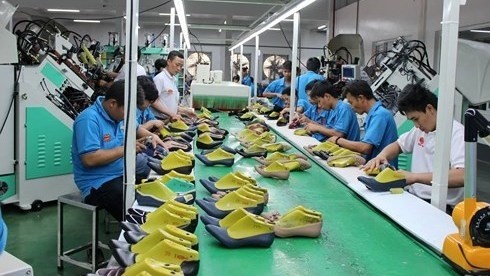Over the past few years, leather and footwear products have had a sustained presence among the top five major export items of Vietnam. The whole sector reported an export revenue of US$18 billion last year, up 10.7% compared to 2016, with a range of products exported to many countries around the world. The United States remains the largest export market for Vietnamese leather and footwear products, accounting for 34% of the sector’s total export turnover, followed by the European Union (EU), the Republic of Korea (RoK), Japan, and China.
According to the Vietnam Leather, Footwear, and Handbag Association (LEFASO), in 2018, the leather and footwear industry will see many favorable factors, which will push the whole sector forward and create breakthroughs to achieve the envisaged goals.
Specifically, the Vietnam-EU Free Trade Agreement (EVFTA) is expected to be signed in mid-2018. Compared to the biggest competitor, China, Vietnam’s footwear products will enjoy a tax difference of 3.5-4.2% on exports to the EU, creating a big competitive advantage. As the agreement comes into force, the tax rate will be reduced to zero.
In addition, the Producers Guild of America (PGA) is accelerating the approval of a new tax bill, which will cut tariffs on several lines of imports, including dozens of footwear and textile products imported from Vietnam.
Particularly, the US’ Skechers Group is researching investment in a large project with about 20,000 workers in Vietnam. The project is expected to create the attraction for a new wave of investment capital after a quiet year in the leather and footwear industry.
Last year, Skechers distributed more than 200 million products and is planning to shift investment from China to Vietnam. They have been investing vigorously in cities and provinces in the southern region, and are eyeing an expansion of investment in the northern region, where Hai Duong province may be the destination for the first project with a projected capital scale of US$700,000 to US$1 billion.
According to a representative of LEFASO, in addition to the favourable factors, Vietnamese leather and footwear businesses will have to face with some challenges this year, including the impacts of the fourth Industrial Revolution (Industry 4.0) and the problem of enhancing labour productivity. Up to 75% of leather and footwear enterprises now find it difficult to invest in automation; only about 20% of them start at a small scale; and less than 5% are planning to make investments in the area. Aside from this, the protectionist policies implemented by certain countries also pose a big challenge to the Vietnamese leather and footwear sector. For example, the United Kingdom (UK) decision to leave the EU has directly affected Vietnam’s leather and footwear exports.
Given these difficulties, LEFASO recommends that, in order to improve competitiveness, enterprises operating in the industry should address the high costs of labour by moving factories to areas with an abundant supply of labour so as to lower production costs, whilst continuing to invest in developing the supporting industries in order to enhance the added value of products and facilitate companies’ proactivity in their production activities. Also, enterprises should produce medium and high-value products instead of low-end products, in the aim of improving their competitive advantage in this segment, compared to other manufacturers.
In 2018, Vietnam’s leather and footwear sector has set a target of US$20 billion in its export revenue, a 10% increase over 2017. To achieve this goal, LEFASO will strengthen its consultation work for government agencies in issuing policies related to firms’ business production activities. At the same time, the association will accelerate the dissemination of State policies and the attraction of domestic and foreign investment to develop the supporting industries producing leather and footwear materials, aiming to increase the localisation rate of products and maintain sustainable development.
















